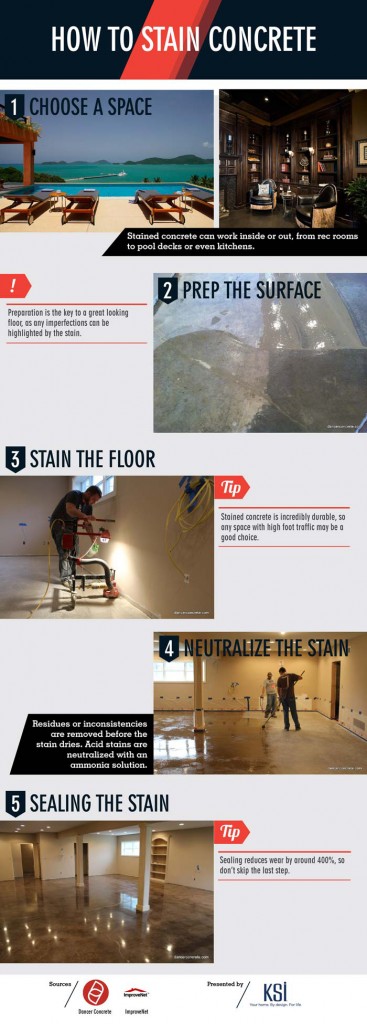Let’s face it: it’s hard to get excited about a plain white or gray concrete floor. The good news is that you’re not stuck with this basic look, even if you’ve moved into a house that already has concrete floors. Staining concrete is becoming a popular choice because it allows you to keep the durability and longevity of concrete while adding color to make the floor more visually appealing.
Staining your concrete floor isn’t too complicated, but there is some room for error and some important decisions that you’ll need to make, so review the below tips before you get started.
Work with a professional. While some ambitious DIY-ers try to tackle the concrete floor staining process on their own, it’s better to hire a professional for several reasons. First of all, if you’re using an acid stain (which we’ll talk about later), you’ll be relying on a chemical reaction to get the right look, and a professional will know how to safely handle the acids and solvents involved. On top of that, if you make an error while applying any type of stain, it’s not always easy to fix the mistake. Work with an experienced contractor to get it right the first time.
Clean the concrete floor before staining. Your contractor should thoroughly clean the concrete floor using a concrete degreaser such as tri sodium phosphate mixed with hot water. This will ensure that there is no residue or debris on the surface that will affect the appearance of the stain.
Choose an acid stain to cover imperfections. There are two general types of stain: acid and acrylic. If your floor has any minor cracks or discolored areas, you’ll most likely want to choose acid, as it does a better job of covering imperfections than acrylic. Just keep in mind that your contractor will need to neutralize the stain using a mixture of ammonia and water after it has been applied.
Choose an acrylic stain if you live in a colder climate. If you live somewhere with cold winters and you’re staining a concrete floor that will be exposed to some of that cold weather (say, a patio or basement floor), you’ll most likely want to choose an acrylic stain since this type is known to do better with extreme temperatures.
Use multiple stain colors to blend into new colors or create interesting patterns. Acid stains only come in eight basic colors, but fortunately you can blend them together to get new looks. You can also select more than one stain color in order to create interesting patterns on the floor (for example, a skilled contractor should be able to give you a marbled look).
Make sure your contractor seals the stain. After your contractor has applied the stain, neutralized it (in the case of an acid stain), and let it dry, he or she will need to seal it using a concrete densifier and a stain guard. This will make the floor more abrasion-resistant, stain-resistant, polished-looking, and long-lasting.
Want even more advice about the concrete staining process? Check out this step-by-step guide from KSI Kitchens.

